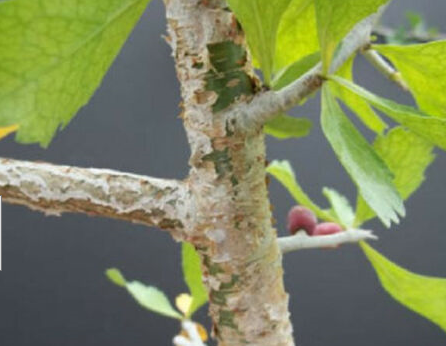 You Don't Need Your Knots -- We Knead Your Knots
You Don't Need Your Knots -- We Knead Your Knots
Myrrh
Essential Oil

The thorny, stunted twisted Myrrh tree is also
known as the Gum Tree, the Guggal Tree, and the Didin Tree. Myrrh is a
reddish resin that comes from Commiphora myrrha, a tree commonly used in
the production of myrrh, which are native to North to Northeast Africa
and the Arabian Peninsula, of desert regions of the eastern
Mediterranean, the Middle East, and North India. It requires dry, sunny,
hot climates in order to thrive and may grow to a height of
approximately 12 feet. Due to the harsh winds and weather conditions the
tree produces few leaves on its jagged and angled branches. At the
beginning of autumn, it produces orange-red flowers and knots from which
is produced a clear or pale-yellow waxy sap. When the drops of sap dry
on the trunk of the tree, they harden and turn reddish-brown in color.
This hardened brittle sap is referred to as resin.
The resin is then harvested to produce an
essential oil which is thick and viscous in its consistency, ranging in
color from yellow to brown. Its aroma is warm, dry, and smoky and can
also have a strong balsamic bitter scent. The scent has also been
described as having similarities to vanilla, mushroom, and licorice.
Myrrh resin has a thicker consistency and different scent profile than
the essential oil, exuding strong but warm notes reminiscent of roasted
cocoa and licorice.
Used in a massage, Myrrh Essential Oil can
promote the relief of bronchitis, colds and coughs. Myrrh Essential Oil
is known to offer relief from the symptoms of the common cold such as,
congestion, coughs and phlegm. Myrrh Oil has properties that make it
beneficial for eliminating or reducing the symptoms of viral infections.
It does this is by reducing mucus in the respiratory tract and relieving
congestion. As a result it has been used in traditional medicine, as a
remedy for hay fever.
In the Hebrew Bible Myrrh is listed as an
ingredient in the holy anointing oil used to anoint high priests and
kings. The name Myrrh comes from the Arabic word “murr,” which means
“bitter,” as its scent is bitter. Myrrh was a valuable commodity along
the ancient spice routes and so esteemed that history has centered on it
with stories of the three wise men that came bearing gifts of Gold,
Frankincense and Myrrh to celebrate the birth of baby Jesus in
Bethlehem.
Myrrh’s scent came to
be associated with somber occasions and solemn religious ceremonies such
as funerals. Myrrh resin was traditionally burned over hot coals, and
the smoke produced a woody aroma that was considered to be conducive for
spiritual practices. For this reason, Myrrh was often combined with
Frankincense and used during religious meditation and prayer.
For its numerous versatile uses, Myrrh has
become one of the most extensively used essential oils around the world.
Myrrh Essential Oil acts as an antiseptic and is known to facilitate the
healing process of wounds by protecting the wound from infection.
Myrrh essential oil
has a clean, earthy smell with a hint of licorice. It has strong
anti-inflammatory properties that help improve skin tone, firmness, and
skin elasticity, reducing the appearance of fine lines and wrinkles.
When used for massage in a blend with carrier oil, Myrrh Essential Oil
facilitates the fading of blemishes on the skin, soothes itchiness, and
reduces symptoms other skin ailments while promoting relaxation. It
effectively cleans, moisturizes, and tightens the skin, thereby reducing
and preventing further chapping, cracking, and sagging.
When
used in a massage blended with carrier oil, Myrrh Essential Oil
strengthens the muscles and smooths the skin cells and thereby prevents
or reduce bleeding. Its anti-inflammatory and anti-oxidant properties
reduce symptoms of indigestion and prevent the build-up of toxins in the
circulatory system. Used in a massage, Myrrh Essential Oil works to
strengthen the muscles and smooths the skin while promoting relaxation.
It also cleanses the pores by increasing the propensity to sweat, and
its anti-inflammatory properties prevent toxins, such as salt, and
harmful gases, from accumulating in the circulatory system. By
stimulating circulation, Myrrh Oil works to supply tissues with oxygen,
which regulates metabolism, addresses symptoms of indigestion, and
boosts immunity. Myrrh Essential Oil’s prevents dandruff helps to
strengthen the roots and thus reduces hair loss when used on the scalp
or in the hair.
According to traditional Chinese medicine, Myrrh
– or Mo Yao, as it is referred to in China – the first record of Myrrh’s
medicinal use in China dates back to A.D. 600 during the Tang Dynasty.
It is considered to be a spicy and bitter essential oil with a
temperature that is neutral as well as a particular effectiveness on the
liver, spleen meridians, and heart. Myrrh is reputed to have stimulating
action for blood circulation, thereby soothing pain and offering relief
from the discomforts of blood stagnation, swelling, sores, carbuncles,
bruises, dysmenorrhea and cramps, abdominal pain, post-partum pain and
spotting, amenorrhea, arthritis, chest pain, and other circulatory
problems. By facilitating the regeneration of skin, it is known to
accelerate the healing of skin ulcers, sores, and lesions. Myrrh Oil is
used for similar applications in Ayurveda, which attributes revitalizing
and tonic properties to the resin.
Myrrh essential Oil is used in the
Blood Circulation,
Hair Growth,
Athlete’s Foot,
Cough,
Stretch Marks &
Cellulite, Skin
Complexion and Colds
& Congestion massage oil blend treatment at Oriental Massage Galway
(OMG).






